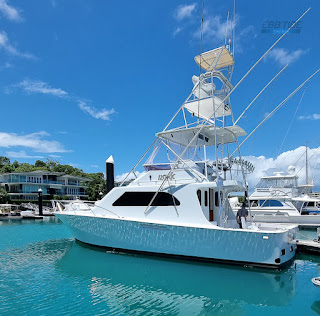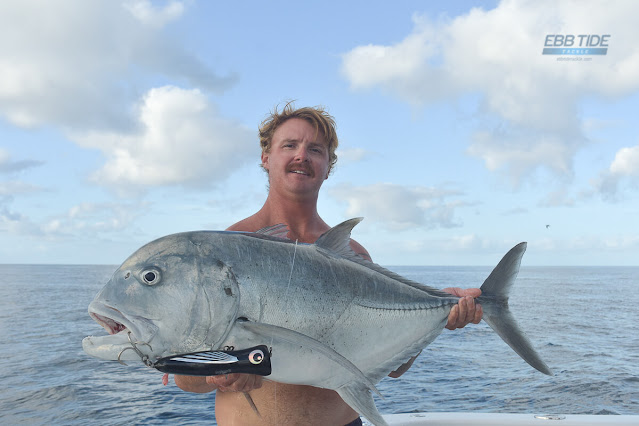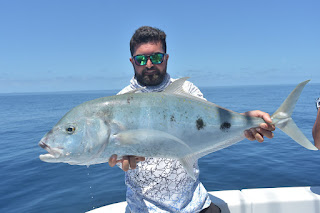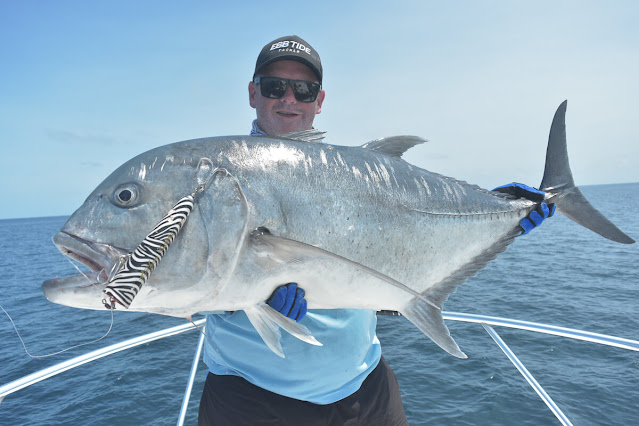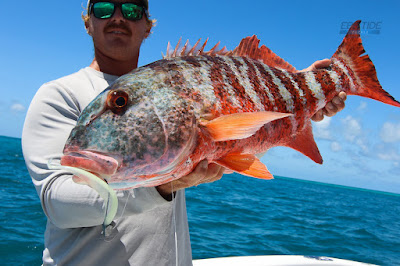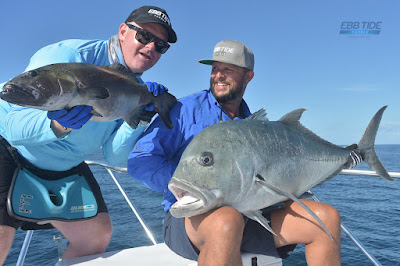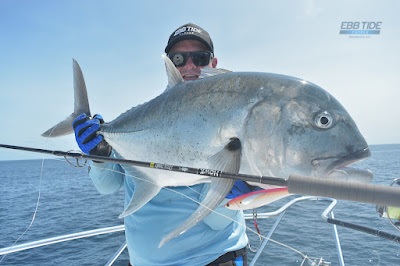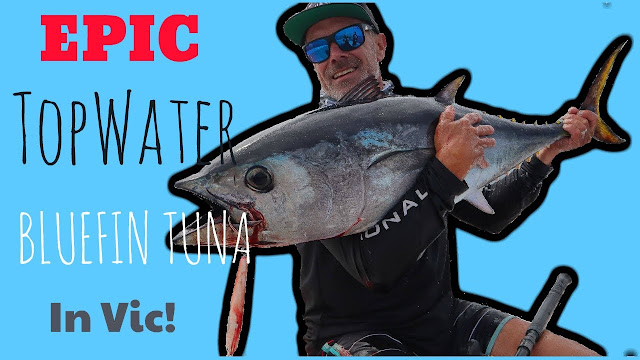By Ebb Tide Tackle and friends
Hey guys it has been a while between posts here and we are catching up on a ton of things that we have been meaning to do. As we head towards summer, one thing we get asked on the regular are “what are good topwater lures for kings” this question has a list of variables as long as a boat ramp queue, but we are going to sort through them all right here and try and give some perspective and knowledge, not just blatant brand recommendations!
While we are at it, lets go a bit deeper into one of our favourite species and most certainly our favourite way to fish for them.
 |
| The topwater game is where the challenge and fun is at |
Now let’s get this out in the open, these are our opinions and not gospel, we aren’t here to say this is the only way because it surely isn’t. In writing this yarn we reached out to some mates, Jake Pyne the landbased kingy tamer and head of the Lo-Cab International crew and Mark Armistead. Now Marks topwater kingy CV probably has no peer, many of the Japanese crews including Konishi San choose to fish with Mark as he still offers a guiding service years after shutting up his charter operation. So this small panel of experts we have really different bases covered from the island and shoreline hugging kelp dwellers to the deep water squid hunters, there are a ton of variables to topwater kingfish.
Straight up, Yellowtail kingfish or yellowtail amberjack (depending on where you are from) have a massive range and we see photos sometimes from Argentina of massive hoods but this piece is written with Australia and New Zealand in mind, no doubt what we say will have some or significant crossover to a range of locations where kings are found globally.
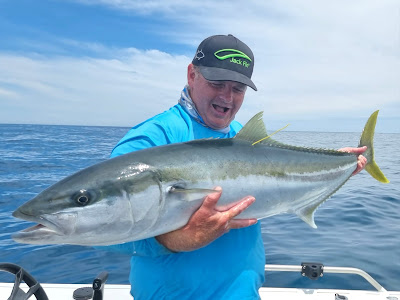 |
| Summer sees a sensational run across the Victoria coastline, here’s a 131cm! |
With no arguments entertained, topwater is THE best way to catch them. The visual aspect of a pack of hoods tracking your stick bait or popper before one commits is exhilarating and the visual memory of it breaking the surface to inhale will stay with you forever. The flip side of this is that topwater can be a tough way to play the game; quite simply you can fire a lot of casts for not much when livebait or jigs may have dominated, but it can go both ways where topwater becomes the true hero so don’t dismiss it as a pointless or elite exercise to just make catching a fish harder than it has to be. More to the point, chasing hoods on topwater should be seen as the goal, and not an alternative or a numbers game.
 |
| Can’t get enough kingfish! |
Now when kings are ‘on’ there are a big range of lures that may get a bite, they are rarely reckless however to the point where any old lure will do. More often they are careful, curious and watchful, often following or tracking a lure without committing to the bite, sometimes they are just downright dismissive towards topwater, following for a cast or two before not responding at all!
But when you get it right and they crash tackle your lure and you come tight it is all worthwhile. The point of telling you this is that if you are serious about TW kings, then what you are throwing really does matter.
Now this article is intended to be an all-inclusive journey so let us dive into a bit of the backstory of topwater kingys first. The technique was pioneered and perfected by Japanese anglers, make no mistake they did it first in the modern era, which was pretty much hand in hand with how they established topwater GT fishing. The early innovators would first prove their tackle on local hard fished waters with both kingfish (Seriola lalandi) and Hamachi (Seriola quinqueradiata) the targets. They would travel in groups led by the pioneers to New Zealand to test their lures and rods and fish with people like Mark who in turn learnt so much. It has probably been through this process year after year that many kiwi topwater anglers believe that it pretty much has to be a Japanese timber lure to be any good for kings and they kind of have a point, the performance of the good Japanese lures tuned for kings are exceptional fish raisers. BUT let me be clear, they don’t have a patent on what fires up kingys and in 2020 a solid number of lures exhibit the attributes that are proven to interest kings but let’s talk much more on lures later.
 |
| Doubles on topwater are THE BEST! |
The Topwater kingfish ‘season’
Is there one? Well kinda due to accessibility really. In the winter months when water temps usually drop significantly in our part of the world (southern Australia) kingfish head out wide to deeper offshore reefs making locating them a difficult TW target but more susceptible to other techniques if you can find the fish. Don’t get me wrong quite big kings still do frequent inshore waters in the colder periods but they are a lot thinner on the ground (but often a lot bigger).
Even so there are exceptions to this, bays, harbours even estuaries can suddenly be alive with kings for a period when their habits say they shouldn’t be, I am convinced because they have become trapped in a pocket of warm water and don’t really want to leave it, especially if there is abundant bait. This regularly occurs in regions and enjoy it if you find fish holed up like that in your favour, you should be in for a good time. This is a big generalisation as we are talking generally here across a vast area, but in spring warmer currents will see the kings start to move inshore in numbers but where they will specifically show up is a year to year proposition no doubt current related and somewhat random but semi predictable in nature due to past patterns, it is a case of if you know you know and by the time the reports filter through the best fishing has probably occurred quite often.
Usually kings will feed veraciously in spring into early summer and once they have spawned tend to end up in smaller schools and put on condition throughout the summer. In our warmer months seemingly they will stay on or around a reef for a few days to weeks to potentially several months depending on the availability of food however they absolutely never ever stay still, constant movement seems the norm which is a significant part of the challenge of locating them on a given fishing day and appearances are often tide dependant, nowhere to be seen on the ebb, and everywhere on the flood or vice versa.
 |
Ranfurly Banks TW kings, probably the pinnacle - nice one for Aaron Dillon
|
Finding kings to cast at!
Random appearances aside, most anglers are dusting off the TW gear in September and keeping an eye on sea surface temperature charts. In Victoria for example if the bait is present water as cool as 15 or 16 degrees could see the first push, on the east coast of New Zealand the guys start to look around 17- degrees, this will give you a huge idea where they will be in your particular zone, warm water licks, current, structure, food and you might just have a winner. No run no fun is an old fishing adage for a reason, and places that combine all three are the spots to look whether you are landbased (safety clearly the most important thing here) or in a boat.
Now via boat things change and open up considerably. Your best friend are good charts and the new C-Map reveal are excellent for identifying contours, ledges, channels (and markers) reef and sharp drops (other mapping with other brands are showing great improvements as well). The right real estate combined with the magic combos of warm water licks, current and bait you are in the zone which will hold fish at one time or another – working that bit out is up to you! Obviously, kings can be found in a ton more places than described open water for one, especially if there is bait you don’t need all the magic ingredients, it could be only one! How you go about finding them with this random nature they are known for can be a challenge. You kind of have two main choices there cover ground and go find them or stick to an A grade area and plan on them turning up at some stage of the tide. Now this is about topwater kings, but if you need to drag a teaser, pull some live baits or jig a pinnacle to bring fish up to get them firstly located before you cast at them so be it, you have to do what you have to do!
Once you have located them, the fun starts. The best thing that you can have is a visual bust up or to spot a cruising school up high in the water (keep your eyes peeled) but another aspect to creating topwater king opportunities, is sounding up kings that are holding deep. Depending how deep, they can be raised by persistent casting, firing them up by jigging or teasing. The moral being that just because they are deeper doesn’t mean they will stay there. Birds seem to be lesser associated with kings than tuna but in my experience that is a bit of a myth, they are just as relevant!
 |
The Simrad lit up with a screen full of kings and bait
|
Kingfish rods
For the rod to be suitable to cast lures (obviously) in some cases small through to moderate sized plugs that are required to cast a long way (needs to be tippy), before we delve too much into the rods themselves, there are a big range of fish sizes and lure sizes to consider here let’s look at the basic characteristics required, they are:
- a springy and responsive tip to effectively work and get the
best from a swimming and lively lure (rod with wrong tip section = a dead lure
and likely a lot less bites) - and the power through the mid to low end to fight a fish
that won’t quit without breaking your back.
In term of fish fighting ability, kings simply do not stop, even when boat side and the sheer power be it from a rat or a donkey is easy to see – they have both power and endurance. I will go on the record that a king of equivalent size goes harder for longer than any equivalent sized GT. The fights are very often vertical too, or if land-based will inevitably end at your feet with a fish that is still diving for the cover of a ledge or kelp bed; you must be able to lift. Now the given is that we are talking about casting here, so rods have to be long. 7’ is at the short end and 7’6” to 8’3” is about right, specialist land-based rods can be much longer again around 10 foot. Basically, a kingfish casting stick has the same characteristics as a tuna rod but are much more forgiving than a GT rod which are faster actioned and tend to punish the angler when things get vertical and are generally designed to cast much heavier and larger lures on average.
 |
Under control and on the leader, but feet from disaster, it's a fine balance
|
Reels
Reels that hold 250 / 300m of your chosen PE is enough capacity, smooth and non-sticky drag is essential (12 – 16 kg at the heavy end) and generally smooth and robust is sound advice, and balanced to your rod for day long stickbaiting sessions is important also. What matters most however is the gear ratio relative to the line retrieved with each crank of the handle. High gear models will be somewhere around 110 – 130cm (1.3m) per crank, while low gear model (usually made for jigging) will be more like 90 to 105cm (or so) per crank. Let me be clear that retrieve ratio makes a massive difference to your cadence when you are getting your stick bait or popper to dance! The slower ratios, despite you furiously winding simply are not fast enough and it will get old very quickly and are borderline ineffective. I am going to talk both Shimano and Daiwa sizes now because they are the most popular for a very good reason, here are some rough sizing considerations that have served me well when it comes to Shimano and modern Daiwa Saltigas and YTK’s.
N.B all line ratings, leader sizes and line recommendations are a rough guide, individual circumstances will dictate this can be much less or more.
6000 – PE 3 or 4, for rats up to 90cm’s – leader up to 100lbs
8000 – PE 5 or 6, for kings up to 120 cm’s – leader up to 150lbs
10000 – PE 6 or 8, for hoods to how big? – Leader up to 180lbs
14000 – PE 8 for the big dogs – leader up to 200lbs
Whilst dealing with reels, lets have the line discussion at the same time, you need quality braid, that’s kinda the end of that discussion! Probably go a tiny bit heavier than what you think you need and buy good quality, not what’s cheap. For leaders see above for length, at least a rods length, preferably more. If you spend any time chasing kings you are going to end up deep in the foul, I
promise you that. You will get slight lure performance differences out of mono or fluorocarbon leaders (float vs sink) so that is a bit of a personal choice and should be determined by the tuning of the lure which incorporates many factors probably most significantly the hooks you add on.
 |
Yamai Suteki Plugging Doubles - super sticky (pic by Lo-CAB)
|
Terminals
Firstly I will say that kings are pretty easy to hook, provided they eat it well. There is ample meaty firm flesh and thick lip to drive a point into, they can however be notorious for swiping at lures and not fully committing to the eat, this is quite common. They do release very well if a degree of care is applied when out of the water but probably the nemesis to their post release health may be deep hooked trebles. Now fish care aside, the average top water kingy guy will spew if he raises a fish and misses the hook up, especially if that was his only chance for the session. That leads me to lean towards trebles and plugging doubles (more on those later). Guys fishing more productive grounds that get more chances at fish won’t be so devo if they miss a bite, there will be another to replace it before too long most likely… That opens up a wider variety of hook options that can fit the need from the trebles or plugging doubles to inline singles, undoubtedly
better for the fish if you are releasing. Hooks are worth a good chat and to be are very circumstantial in terms of what I would recommend you use. Let me explain in a bit of detail.
 |
Barbless trebles (or singles) aid in successful catch and release
|
Trebles might have the runs on the board and potentially take the chocolates in terms of sticking fish, as usually one of the points will find something to pin into and are also very good in many cases at getting the best swimming action from your lure. A relative new player however are plugging doubles and short assist singles that are amazing at attaching to fish and can result in a better lure ‘tune’ than running singles alone. They seem to manage a way to hook fish very well and are hard to throw out especially if the fish makes it to the kelp or foul where trebles very often bury and the fish is lost too regularly, but the singles regularly seem to pull through and hold on.
A final word on hooks, regardless of what you choose are consider lure tuning. Regularly devoting time in different sea conditions to using a range of kingy lures with different hook combinations will show you that small variants to hooks or rings for example can actually make a big difference. That lure you think is a pig or a bit dull just might need some hook fine tuning, you simply can’t do this enough and this alone will catch you more fish.
 |
OOOF, Jake from Lo-CAB with a big animal from the wash
|
Lures
Now all the talk about the Japanese pioneers has relevance here, the lure design, R and D and good old-fashioned trial and error resulted in some very effective topwater plugs. There is a huge range of lures that work to match the huge range of situations and sizes that kings may be encountered, from 30g / 80mm to 200g / 260 mm and everything in between. All of our experts agree on a few things and differ on a couple, lets go….
The perfect Kingfish topwater lure is a floating stickbait…
Wile nothing is perfect, there is one close lure, a Carpenter Bluefish. Let’s not sugar coat it, the action and performance of the Bluefish has probably gone close to accounting for more big TW kings than any lure! Before you stop reading and rush out to buy all the Bluefish you can get your hands on (they aren’t cheap and are hard to source) lets look at the formula of what a Bluefish does and we get a few big clues on what works for kings a lot of the time, remember they don’t want it because it’s a Carpenter Bluefish, they want it because of what it does! It’s all in the swim guys and for everyone desirable attributes of a lure will vary. Some guys like the rhythmic beating of tight actioned swim (such as many tuna lures or even bibbed minnows) compared with the
eclectic swim of a tuned kingy lure which is just that, eclectic! They dart, they dive, they break the surface and slash before gripping in the water and diving again. No two casts will produce the same result, and this drives kingys crazy because it looks very much like a panicked baitfish trying anything it can do to escape and this is their Achilles heel! This is what the Bluefish does so well, and it happens through great design – highly buoyant, precision weighting and shape.
Another hugely effective lure is one that represents a fleeing garfish. And Kingfish love garfish like crack cocaine! Even if they aren’t feeding, a fleeing gar imitation is a BIG CHANCE to flick the switch and get mauled! And there is no better fleeling Garfish that a JACK FIN STYLO! The Jack Fin Stylo 240 has made its name in the underground brotherhood of kingfish tragics, and rightfully so. It’s now on the verge of popular explosion and is an essential lure in any kingfish kit.
Now to back track a little to the rhythmic beating ‘predictable’ swimming lure, for sure they will still catch kings, fish do make mistakes and might be young and dumb or have not been under pressure, you also can fish these types of lures different ways to impart different responses but on the whole they lack the excitement factor to get kings fired up and unable to resist at least on a consistent basis. Now a ton of lure designers have worked out the kingfish formula (erratic / excited / escaping) and created their own interpretation and you do not have to source a Bluefish, there are a plethora of Japanese and other designs that do this job very well. I will list the Ebb Tide tackle Options at the end of the article for your reference.
 |
| Solid SW Vic kingfish! |
What else is there? Sinking sticks?
Much less popular on the whole! It’s a tad harder to get that excitement factor into a sinking lure than on the surface but there are certainly occasions where a sinking lure provides an advantage. Be it inshore or offshore, conditions can dictate that it’s actually the only thing that will work sometimes. Reason being, when it gets really rough through wind or current or both, in those circumstances the floating sticks can spend way too much time flying through the air and not even closely resembling a baitfish. Add in stacks of sea birds such as gannets grabbing your lure and a floating stick may just not work, the famous New Zealand ‘work up’s often have kingfish under the kahawai on the surface and sinking a lure is not only necessary it also makes sense. In any of these circumstances a sinking stick depending on a bunch of factors not limited to sink time, sink rate, current etc will really be so close to the surface it’s hardly down there dragging the depths but at least it’s below the surface, this is really their time to shine.
Pop, pop, boom? Well kinda
Poppers and kingys don’t always go together, but they also work really well and are VERY UNDERATED. Not meant to confuse but I know I have so I need to explain! Poppers on the whole do a really great job of raising kings, but sticks can sometimes get way more bites! Especially if you are using large chugger style poppers, more likely intended for GT’s. Now if you modify the approach for a popper with a smaller face that splashes more than it pops, swims and darts more than it chugs and you have probably got a winner, and a diving popper is ideal. This is exactly what they do! The right popper attributes fit nicely in alignment with the style of lures that get kingys excited so do not ignore them especially if the stickys aren’t getting a bite. The range or poppers can also broadly include skipping pencils at a stretch as fleeing garfish (piper if you’re from NZ) are an absolute favourite forage.
 |
| Tag & release is a solid option! |
Ebb Tide Topwater Kingfish Gear
We have come full circle back to the question we get asked all the time! We pride ourselves on knowing our gear and proving it on fish ourselves. We like to sell knowledge over product, so what we put in front of you works because we have seen it work for ourselves. Lets run through our kingy specific TW stuff piece by piece, there is a bit. Of course if you want advice please hit us up, but it will help if you have read this first.
Rods
The Howk Bullfighter range are perfect for this application. Yes they are tuna rods, but as I said in the rod section, tuna rods and kingys sticks share the same characteristics. These are Japanese blanks and stack up to any made and yes that is a big claim. The Little Tunny is also a great option for smaller fish as it has a similar fighting curve albeit a lot shorter. Here is my rough guide:
Howk Little Tunny, 6000 size reel – PE 3 or 4, for fish to 100cm’s or so
Howk Bullfighter 150, 8000 or 10000 sized reel – PE 5, 6, or
8 for kings up to 120 cm’s or so
Howk Bullfighter 170, 10000 or 14000 reel – PE 6 or 8, for
hoods to 140cm
Howk Bullfighter 200, 14000 reel – PE 8 for the XL big dogs or
for landbased action
If you are after more general purpose rods that are engineered more towards tropical reef fishing but will still perform well at topwater kingfish application, check the Temple Reef Stealth or Ronin PE6 range
Lures, starting with floating sticks (in no particular order)
Jack Fin Stylo 240 (240mm) resin, made in Italy NEW RELEASE AND DOMINATING!
Jack Fin Argo (180mm to 240mm) resin, made in Italy
Megabass Or-Poi Floating (148mm) Plastic, made in Jap
CB One Ryan (130mm through to the big dog 250mm) – Timber,
made in Japan.
CB One Zorro (140mm through to the 270mm) – Timber, made in
Japan.
CB One Rodeo (135mm to 185mm) – Timber, made in Japan
Poppers
Jack Fin Kronos 180 (88g) Resin, made in Italy
Heru Skipjack (30g 50 180g) Timber, made in Indonesia
Heru Tuna (60g 80 100 120g) Timber, made in Indonesia
Tackle House Contact Feed (100mm – 120mm) – Plastic, made in Japan
CB One Dixon (180mm to 200mm) Timber, made in Japan
Sinking sticks
Jack Fin Pelagus 165S (165mm) Resin, made in Italy
Jack Fin LARA 135 (135mm) Resin, made in Italy
Megabass OrPoi Sinking (148mm) Plastic, made in Japan
Heru Wahoo (145mm – 265mm) Timber, made in Indonesia
Tackle House Contact Brit (145mm – 175mm), plastic, made in Japan
Orion Mr Joe (135mm), resin, made in France
Bassday Bungycast (100mm) plastic, made in Japan
Terminals for Topwater
Gamakatsu GT Recorder trebles (barbless)
Shout Curve Treble 31
Shout Single Kudako Assist
Shout Ringed Kudako
Yamai Suteki Crafter (barbless single)
Yamai Suteki Crafter (barbed single)
Yamai Suteki Plugging Double
Yamai Suteki Plugging Single
